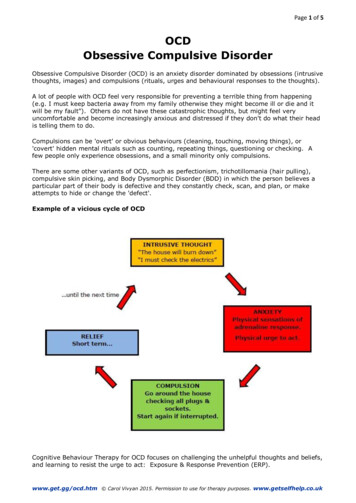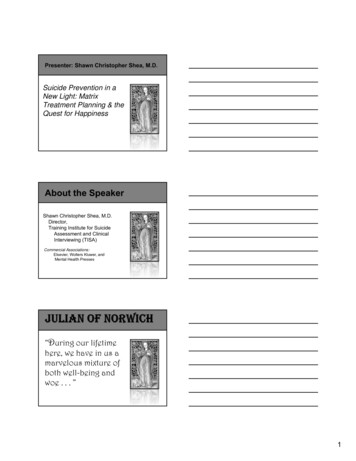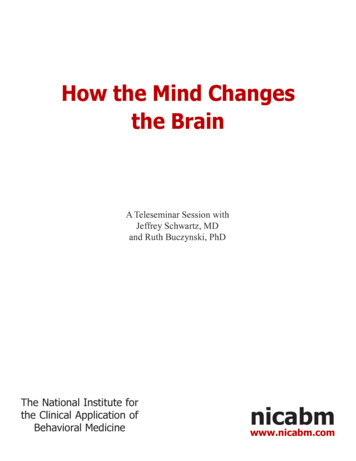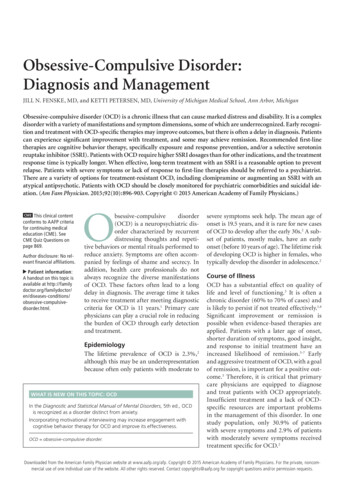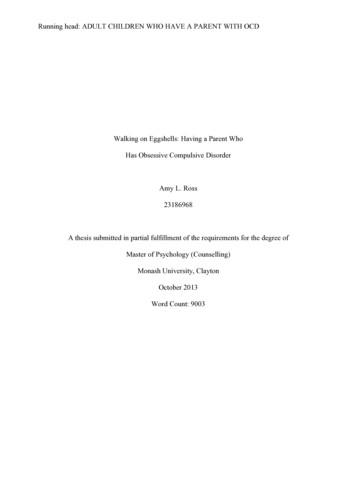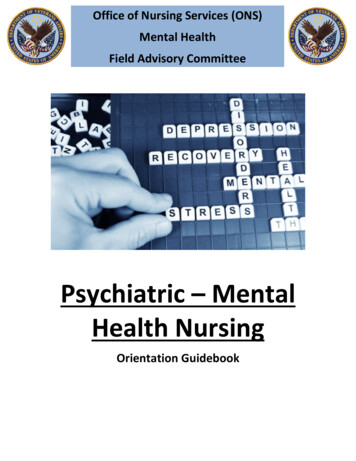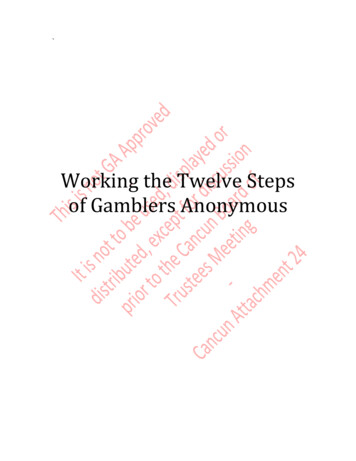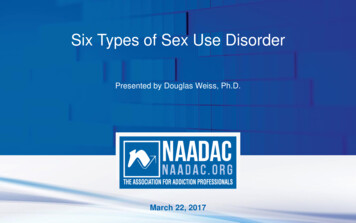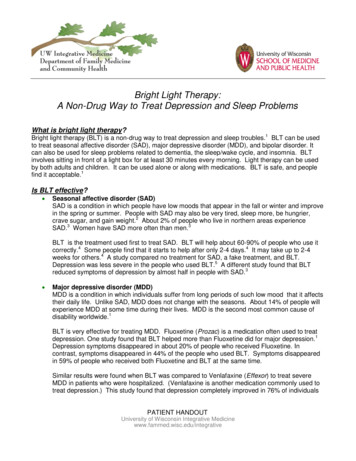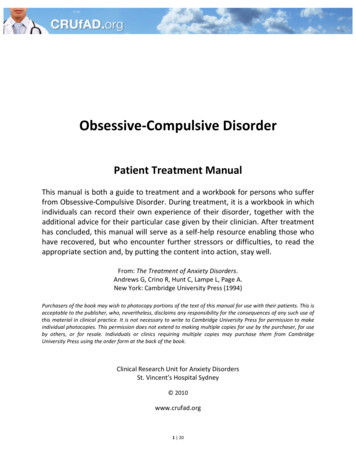
Transcription
Obsessive‐Compulsive DisorderPatient Treatment ManualThis manual is both a guide to treatment and a workbook for persons who sufferfrom Obsessive‐Compulsive Disorder. During treatment, it is a workbook in whichindividuals can record their own experience of their disorder, together with theadditional advice for their particular case given by their clinician. After treatmenthas concluded, this manual will serve as a self‐help resource enabling those whohave recovered, but who encounter further stressors or difficulties, to read theappropriate section and, by putting the content into action, stay well.From: The Treatment of Anxiety Disorders.Andrews G, Crino R, Hunt C, Lampe L, Page A.New York: Cambridge University Press (1994)Purchasers of the book may wish to photocopy portions of the text of this manual for use with their patients. This isacceptable to the publisher, who, nevertheless, disclaims any responsibility for the consequences of any such use ofthis material in clinical practice. It is not necessary to write to Cambridge University Press for permission to makeindividual photocopies. This permission does not extend to making multiple copies for use by the purchaser, for useby others, or for resale. Individuals or clinics requiring multiple copies may purchase them from CambridgeUniversity Press using the order form at the back of the book.Clinical Research Unit for Anxiety DisordersSt. Vincent’s Hospital Sydney 2010www.crufad.org1 20
Section 11. The Nature Obsessive-Compulsive DisorderObsessive-compulsive disorder (OCD) is an anxiety disorder that, until quite recently, wasregarded as a rare condition. Recent studies have shown that OCD is considerably more commonthan previously thought and as many as two in every hundred people may suffer from thecondition.OCD is characterized by persistent, intrusive, unwanted thoughts that the sufferer is unable tocontrol. Such thoughts are often very distressing and result in discomfort. Many OCD sufferersalso engage in rituals or compulsions that are persistent needs or urges to perform certainbehaviors in order to reduce their anxiety or discomfort. Often the rituals are associated with anobsessional thought. For example, washing in order to avoid contamination follows thoughtsabout possible contamination. For some, there is no apparent connection between the intrusivethought and the behavior for example, not stepping on cracks in the sidewalk in order to avoidharm befalling one’s family. Others still have no compulsive behaviors and suffer fromobsessional thoughts alone, while others do not experience obsessions but have compulsiverituals alone.The one common element to the various symptoms in OCD is anxiety or discomfort. For thosesuffering both obsessional thoughts and compulsive rituals, it is the anxiety or discomfortassociated with the thought that drives the ritual. In other words, the ritual is performed to reducethe anxiety produced by the thought. For those suffering from obsessional thoughts alone, anxietyis often associated with the thought, and mental rituals, distraction, or avoidance may be used tolessen the discomfort. It is much the same for those with compulsive rituals alone in that thebehavior is performed in order to lessen the urge to ritualize. The role of anxiety is important inOCD and will be discussed in much greater detail in subsequent sections.Most OCD sufferers can see the uselessness and absurdity of their actions but still feel compelledto perform their various rituals. They know that their hands are not dirty or contaminated and theyknow that their house will not burn down if they leave the electric kettle switched on at the wall.Because they are aware of how irrational their behavior is, many sufferers are ashamed of theiractions and go to great lengths to hide their symptoms from family, friends, and, unfortunately,even their doctors. It is extremely important that your therapist is aware of all of your symptomsno matter how embarrassing or shameful they may be, as this is the only way that a suitabletreatment program can be designed for you. Rest assured that a therapist experienced in thetreatment of OCD will have heard of symptoms worse than yours many times over.1.1 Symptoms Obsessive-Compulsive DisorderObsessional thoughts are usually concerned with contamination, harm to self or others, disasters,blasphemy, violence, sex or other distressing topics. Although generally called thoughts theycan quite often be images or scenes that enter the sufferer’s mind and cause distress. For example,one sufferer may have the thought “My hands are dirty” enter his head. This thought will triggerwashing rituals. Another sufferer will actually have enter his head the scene of his house burningdown. This scene will trigger checking rituals. Individuals who suffer obsessions alone may alsoexperience thoughts, images, or scenes. For example, someone who has obsessions about harming
his or her children may have the thought of harming them or have a frightening scene of hurtingthem or an image of the children already hurt.As was pointed out earlier, many obsessions produce anxiety or discomfort that is relieved byperforming rituals. The most common rituals are washing and checking, although there are manyothers such as counting, arranging, or doing things such as dressing in a rigid, orderly fashion.Although rituals are performed to alleviate the anxiety or discomfort that is produced by theobsession, the anxiety relief is usually short-lived. An individual who washes in order to avoid orovercome contamination will often find him- or herself washing repeatedly, because either theywere uncertain whether they did a thorough enough job or because the obsessional thought thatthey are contaminated has recurred. Similarly, someone who checks light switches, stoves, and soforth in order to avoid the house burning down, often has to repeat the behavior over and over,because he may not have done it properly or the thought or image of his house being destroyedhas recurred. Even individuals who have obsessional thoughts alone may find that they have torepeat the cognitive rituals such as counting or praying many times over as they may not havedone them perfectly in the first place.An important point to keep in mind is that many sufferers have more than one type of symptomso that individuals may engage in more than one type of ritual or have more than one type ofobsessional thought. Another point to note is that symptoms change over time and someone whois predominately a washer may, over time, develop checking rituals that eventually supersede theoriginal complaint. In addition to changes in symptoms, the course of the disorder may alsofluctuate over time, with periods of worsening and periods of improvement. Other sufferers mayfind that their symptoms remain static, while yet others may find a gradual worsening ofsymptoms since the onset of the disorder.For many sufferers of OCD, these symptoms take up a great deal of time, often resulting in theirbeing late for appointments and work and causing considerable disruption and interference withtheir lives. Apart from disrupting their own lives, it also frequently interferes with the lives offamily members as the typical sufferer often asks the other members to do things a certain way ornot to engage in certain behaviors, as this may prompt the sufferer to engage in rituals. Thus, thesymptoms are not only controlling, frustrating, and irritating to the patients, but also to theirfamily, friends, and workmates.Avoidance of certain situations or objects that may trigger discomfort and rituals is also quitecommon among OCD sufferers. It seems logical to avoid contact with contaminants if you are aperson who washes compulsively, or to avoid going out of the house if you must check all theelectrical equipment, the doors, and windows. While this seems like a reasonable way of coping,it actually adds to the problem, as the typical sufferer avoids more and more situations andgradually the problem comes to rule their life. Second, avoidance does little to deal with theproblem as it only serves to reinforce the idea that such situations are dangerous. Because thesituation or object is constantly avoided, there is no opportunity for the individual to learn thatthere is no danger.
Section 22. The Causes and Treatment OCDTo date, no one is certain of the causes of OCD. Though there are a number of theories thatattempt to explain the development of the condition, there is little evidence to support them. Weknow that for some the onset is during childhood, while for others, the onset may be duringadolescence or early adulthood. We also know that in some cases the onset is sudden, whileothers have a slow, insidious onset. Some of the theories that have been proposed to explain thedevelopment of OCD follow.2.1 The Biochemical TheoryThis theory was put forward after it was found that certain medications were of benefit in thetreatment of OCD. These drugs mainly affect one type of chemical in the brain called serotonin.Consequently, it was hypothesized that a problem with serotonin could be the cause of OCD.Although the drugs are indeed effective in the treatment of this condition, there is little hardevidence to indicate that sufferers have a deficit of serotonin in their brain.2.2 The Genetic TheoryThis theory was put forward to explain the finding that OCD can sometimes occur in families.Although a genetic predisposition may account for some sufferers developing the condition,there is also the strong possibility that the OCD behavior was learned from the parents or siblings.It is extremely difficult to differentiate between OCD behavior thay may be the result of geneticsor OCD behavior that may be the result of the environment.2.3 Learning TheoryThis model suggests that obsessive-compulsive behavior has been learned through a process ofconditioning. Put simply, this theory states that a neutral event becomes associated with fear bybeing paired with something that provokes fear, anxiety, or discomfort. This fear then generalizesso that objects as well as thoughts and images also produce discomfort. The individual thenengages in behaviors that reduce the anxiety and because the behavior is successful in reducinganxiety even if only for short periods of time it is performed each time discomfort or anxiety isfelt. The problem with this theory is that it fails to explain why particular fears such ascontamination or of harm to oneself and others commonly occur in OCD. Another problem isthat many sufferers do not recall any significant precipitating event that can explain the onset oftheir symptoms. However, this theory does explain how obsessive-compulsive symptoms aremaintained, and as a result, this issue will be dealt with in much greater detail in subsequentsections.2.4 Psychoanalytic TheoryThis theory basically states that obsessive-compulsive symptoms are attempts to keepunconscious conflicts and impulses from conscious awareness. Unfortunately, there is littleevidence to support this theory and psychoanalysis is of little value in the treatment of themajority of OCD sufferers. As can be seen, no theory is able to adequately explain thedevelopment of OCD but that does not mean that there are no effective treatments. In fact, thecause, though of considerable interest, has little bearing on treatment outcome. It is important tonote, however, that in some cases symptoms that resemble OCD may be the result of otherillnesses such as depression and schizophrenia. Effective treatment of these conditions will
generally result in a decrease in the OCD-like symptoms. Other conditions that may result insymptoms that resemble OCD are Tourette’s Syndrome, dementia, brain trauma, or otherneurological disorders.2.5 The Treatment Obsessive-Compulsive DisorderThere are currently two effective treatments available for OCD that may be used separately ortogether. One is drug treatment, with medication that increases the availability of serotonin in thebrain; the other involves the use of behavior therapy techniques. At present, it appears that theyare both effective and there is little in the scientific literature to suggest that combining the tworesults in a better outcome than using them individually. However, some sufferers who findbehavior therapy too difficult initially may benefit from a course of medication so that effectivebehavior therapy can be undertaken.2.5.1 MedicationThe medications that have been found to be particularly helpful in the treatment of OCD comefrom the antidepressant family of drugs and include clomipramine, fluoxetine, fluvoxamine, andsertraline. They have specific effects on serotonin levels in the brain. Serotonin is the biochemicalsubstance that some researchers believe is involved in OCD. In general, these medications havebeen shown to be effective for some OCD sufferers and assist them in bringing their symptomsunder control. If one of these medications is prescribed for you, you should be made aware ofpossible side effects and report their occurrence to your therapist. It is important to remember thatthese medications are not a cure for OCD. In addition, research indicates that ceasing themedication in the short term generally results in a return of symptoms. It could be that sufferersneed to remain on the medication for long periods of time or that behavior therapy should be usedin conjunction with the drug.2.5.2. Behavior TherapyThe rationale for using behavioral techniques is briefly explained in the learning theory sectionabove but it is important enough to state again in greater detail. Typically, the OCD sufferer hasintrusive thoughts that generate anxiety, discomfort, or an urge to carry out a ritual. Performingthe ritual results in a decrease in anxiety or discomfort, so that performing the ritual is actuallyreinforcing through its ability to reduce these negative feelings. For example, an individual hasthe thought that his or her hands may have touched something dirty or contaminated. This thoughtproduces anxiety in that the person feels uncomfortable about the possibility of beingcontaminated or contaminating someone else. This unpleasant anxiety or discomfort is relievedby washing of the hands or other contaminated objects and it feels good to rid oneself of suchnegative feelings, so it feels “good” to wash. In the same manner, an individual who must checkthe stove and heaters prior to leaving home in order not to cause a disastrous fire will feel somerelief after checking these items many times to ensure they are off. Thus the anxiety-producingthought is temporarily minimized by checking, and it feels “good” to check.This anxiety- or discomfort-reducing quality that the rituals possess is shown in the followinggraph. Patients were asked to rate their levels of discomfort and urge to ritualize (1) before beingexposed to an anxiety-evoking stimulus, (2) after being exposed, and (3) after performing theirrituals. As can be seen, exposure to the stimulus results in a marked increase in discomfort andurge to ritualize. Engaging in the ritual brings about an immediate and dramatic decrease in boththese measures.
Though the decrease may be short-lived, the individual very quickly learns that the discomfortmay be reduced again by performing the ritual. The more anxious the individual feels, the moreritualizing they engage in. This is further worsened by their inability to concentrate on what theyare doing to the extent that they are unsure that the ritual was conducted properly. This adds totheir anxiety, which they try to bring under control by ritualizing further. For example, anindividual who checks electrical equipment, doors, and windows prior to leaving home learnsvery quickly that checking alleviates the discomfort associated with the thought that the housemay burn down or be broken into. The individual may have to perform the checking rituals anumber of times in order to gain some relief. If he or she is under pressure from other sources andis preoccupied or distracted by these other worries, then they will have to engage in the ritualsmany more times because they may not have been done “correctly” the first few times. Havingseen how compulsive rituals are maintained, the important question is what can be done to breakthe vicious cycle between the discomfort-producing thought and the anxiety-reducing ritualsAgain, research into the condition provides the answer.
Section 33 Exposure and Response PreventionInvestigators looking at the phenomenology of OCD examined what happened when suffererswere exposed to stimuli that triggered rituals and were asked not to engage in their rituals.Initially, there was a significant rise in anxiety, discomfort, and urge to ritualize. Rather thancontinue to get worse, however, this rise remained quite steady and then gradually decreased sothat by the end of the session, the level of discomfort had almost returned to normal. When thisprocess was repeated again and again, the surprising finding was that the initial discomfort andanxiety was less with each exposure and the time taken to return to normal was shortened so thateventually exposure to the stimulus would result in a “hiccup” in anxiety that would then quicklysettle. The initial findings of this research are demonstrated in the following graph.These findings led to the development of the behavioral treatment known as exposure andresponse prevention. As the names suggest, the two elements of this treatment are: exposure to the cues or triggers of the compulsive rituals, andprevention of the ritualized responsePrevention does not mean that the person suffering from the condition is restrained or held backfrom performing the ritual but rather that the individual, with the help of the therapist, voluntarilydoes not engage in the ritual.In repeating this process of exposure combined with response (ritual) prevention, the end result isone of perhaps mild discomfort when confronted with triggers for the rituals, but the most
important change is that the individual is now in a position to control the problem rather thanhaving it control him or her.When sufferers are made aware of this form of treatment, the initial reaction is either one ofdisbelief that such simple methods may work or alternatively that it appears extremely difficult.First, this form of treatment is not as simple as it seems. The approach must be structured,planned, and systematic in order to have maximum benefit. The individual needs to be motivatedand consistent in his or her efforts to overcome the problem and faithfully follow all homeworkand clinic assignments. Approaching the problem in a haphazard manner will invariably result ina less than optimal outcome, with sufferers feeling disappointed, frustrated, and hopeless. Aconsistent and planned approach ensures that the problem is dealt with in a systematic manner.Any difficulties encountered can be quickly dealt with by the patient with the assistance of thetherapist. Second, for those who see this approach as too difficult, the fact that the treatmentprogram is planned by you in conjunction with the therapist ensures that the pace is at a level youare capable of mastering and the various steps can be graded to maximize your chances ofsuccess.3.1 Obsessional ThoughtsThe principles of exposure and response prevention are also applied to the treatment ofobsessional thoughts and images, except that there are no obvious behavioral rituals to work on.This does not mean that someone who has int rusive thoughts does not engage in rituals to reduceanxiety and discomfort; it is just that the rituals may also be thoughts. If, for example, anindividual with OCD experiences frequent blasphemous thoughts, he or she may attempt toreduce the discomfort by saying a short prayer to him- or herself. Similarly, individuals who havethoughts of harming their children will often deal with the anxiety that such a thought producesby trying to push it out of their head or by desperately reassuring themselves that they love theirchildren and would never harm them.Other sufferers with obsessional thoughts alone often have more elaborate and definite rituals.For example, having to mentally retrace their steps to ensure they did not harm anyone whiledriving to their destination, or having to remember whether anything sharp stuck into their bodybecause they fear contracting AIDS, or having to say something a certain number of times inorder to avoid some disaster. When the problem of obsessional thoughts is conceptualized in thisway, the treatment for the condition is readily apparent and involves exposure to the anxietyprovoking thought while, at the same time, not engaging in cognitive or mental rituals to lessenthe discomfort.There are, however, some important differences in the treatment of obsessional thoughts,especially considering that exposure to thoughts is not as easy as exposure to concrete objects:Treatment involves confronting the thought or image until it no longer causes the individualdistress or discomfort. For those who suffer from obsessional thoughts, this may seem to be animpossible task, but when you consider that everyone experiences unpleasant, strange, or bizarrethoughts, then the goal of treatment appears more realistic. The major difference betweenobsessionals and everyone else is the meaning they attach to their intrusive thoughts. Anindividual who does not suffer from OCD will experience an intrusive thought but will dismissthe thought as silly and it will be gone. If it does recur, then it is again regarded as silly andmeaningless and dismissed. Someone suffering from OCD, however, may experience the samethought and will desperately try not to think about it or will try to think of something to negate orcancel the thought. In other words, they react with fear, dread, and anxiety, so that the chances ofthe thought recurring and causing further distress is greatly heightened. Attempts to not think
about the thought is like trying to not think of a pink elephant, whereas attempts to negate itthrough mental rituals only serve to reinforce the thought’s apparent power. Put simply, it’s yourfear of the thought that ensures its continued return and your continued distress. The object oftreatment is to disengage the emotional meaning of the thought from the thought itself so that isbecomes “just another thought.” This result is achieved through the exposure program.Exposure should not only involve the obsessional thoughts but also must include any situationsthat the individual has been avoiding because of the possibility that the thoughts may be elicited.For example, a sufferer who fears harming his or her children may avoid contact with knives orother sharp objects while the children are around, or someone with blasphemous thoughts mayavoid going to church for fear of bringing on the thoughts while there. Avoidance of suchsituations needs to be overcome in order to maximize and maintain the gains made fromtreatment.3.2 Basic Rules for SuccessThe first requirement for the success of this treatment is motivation. Overcoming OCD is difficultand requires persistent effort on the part of the sufferer. Obviously, there will be periods whentreatment is going smoothly and others when the progress is slow and difficult. The importantpoints to bear in mind are that the problems have been with you for a considerable period of timeand are probably well ingrained in your daily routine. Overcoming these difficulties will mostcertainly take time and you should allow yourself as much time as it takes to get yourself better.You don’t need to add to your difficulties by being impatient. Second, progress is not in a straightline but tends to be fluctuating so that having occasional bad days is the rule rather than theexception. The two graphs below are to demonstrate the difference between what people expectto happen and what actually happens.
The response to treatment that most people expect is linear, in that they start treatment and expectto get better and better. What actually happens, however, is that there are fluctuations from day today with some days being worse or better than others. When the fluctuations in the second graphare evened out (dotted line), it becomes obvious that the individual is improving even though attimes it may not feel as though they are getting better. They may even feel as though they areslipping back. It is important to reassure yourself that having a bad day does not mean that thesituation is hopeless or that you are back to square one. In fact, the only individuals sure to returnto square one are those who lose their motivation and no longer persist with the program.Another basic requirement for a positive outcome is, for want of a better word, honesty. You needto be honest with yourself and your therapist in terms of your fears, avoidance, rituals, andthoughts. At times, individuals who know they have to be exposed to situations they have avoidedfor long periods of time will avoid telling the therapist about similar situations or will notcomplete homework assignments. This does nothing to help the sufferer overcome the problem inany way. Telling yourself that the problem will be dealt with later is just another form ofavoidance. It is important that you keep your therapist informed of your progress, difficulties, andfears at all times so that, if need be, the program can be modified to suit your needs. Others mayavoid telling the therapist important information because they are embarrassed by the content oftheir thoughts or the nature of their rituals. Keeping this information to oneself means that thetreatment program will not be comprehensive and ensures that the outcome will not be assuccessful as it could have been. As stated before, your therapist will have dealt with many OCDsufferers and no doubt will have heard of problems such as yours many times over. These typesof thoughts and rituals are quite common among sufferers, even though they may seem bizarre orstrange to you.Another important issue ties in with motivation. By attending the clinic, you have decided that itis time to work on your OCD problems. That is exactly what you should focus on doing to theexclusion of all else except the essentials. Your progress will be impeded if you have to deal withother issues such as moving to another house, leaving your partner, starting a new job, and soforth. It is essential that you set aside the time to work on your problems without the distractionposed by these other issues. If distractions are pressing, deal with them before commencingtreatment and allow some time for yourself to come to terms with the changes.The final important issue is that of self-mastery.As you progress through the program, you will gradually gain confidence indealing with the OCD problems. In order to gain this sense of mastery overthe problem, it is essential that you do not use anxiety-reducing drugs, illegaldrugs, or alcohol while participating in the program as use of suchsubstances results in your attributing positive changes to the drugs ratherthan to yourself.
Section 44. The Treatment ProgramIn previous sections an outline of the rationale and principles of treatment havebeen discussed. This section will review some of the important points and discussthe design of your treatment program. As mentioned above, treatment consists ofrepeatedly exposing the individual for prolonged periods (45 minutes to twohours) to circumstances that produce discomfort. In the initial sessions, suchexposure will be under the supervision of your therapist who will be with youthroughout the task. Sessions may be conducted at the clinic, at your home, or inother settings where the rituals are a problem. The exposure is graded so thatmoderately disturbing situations are effectively dealt with before proceeding withmore difficult ones. By breaking down the problems into steps and mastering eachstep before moving on to the next one, you will find that what may seem likeinsurmountable problems become manageable. The sessions are held daily, withdaily homework tasks being set during each session.The importance of homework tasks cannot be overestimated, as it is withperformance of these tasks that most of the treatment gains will occur. It is of littleuse to only engage in the exposure and response prevention while at the clinic. Bycompleting your homework tasks faithfully, you are ensuring that what is beingachieved at the clinic will transfer to the outside environment as well asreinforcing what has been learned during each session. Throughout the exposure,individuals are requested to refrain from ritualizing, regardless of the urges to doso. You should be prepared to experience some discomfort but you can restassured that it will be considerably less than what you will anticipate. In fact, thisis one of the major difficulties when describing this type of treatment to patients.Most sufferers fear that when exposed to a stimulus that evokes discomfort theiranxiety will continue to rise for as long as they do not perform the ritual, until iteventually becomes unbearable. This is not the case. As described in previoussections, the discomfort will peak and then gradually decay, and each subsequentexposure will be less distressing and the decay will occur more rapidly.
4.1 Program DesignThe first step in designing your individual program is to conduct a thorough analysis of yourdifficulties by breaking down the problem into its various components.A.CUES OR TRIGGERSIn the space below, please list the objects, situations, or circumstances that cause you discomfortor anxiety in regards to your OCD. What are specifically being looked for are the triggers to yourrituals. Once you have listed them, your therapist will help you rate them in terms of theirdiscomfort evoking abilities.Cue or Tr
Obsessive‐Compulsive Disorder Patient Treatment Manual This manual is both a guide to treatment and a workbook for persons who suffer from Obsessive‐Compulsive Disorder. During treatment, it is a workbook in which individuals can record their own experience of their disorder, together with theFile Size: 838KB
